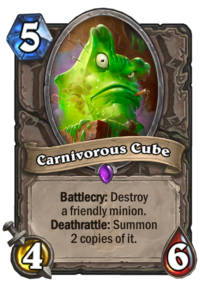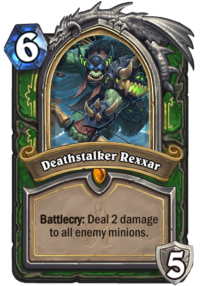One of the more amusing talking points from Hearthstone’s state before the recent patch revolved around the almost complete lack of cards from 2018’s sets in the HCT Philadelphia tournament. Only 24 copies made it into the that formed the top eight players’ decklists overall, amounting to a whopping 2,5%. With only very few brand new archetypes – or hardly any, depending on who you ask – making waves in the Rastakhan meta so far, one has to wonder whether this is an overwhelming design issue with the Year of the Raven or a necessary downturn from the sugar high that was Knights of the Frozen Throne and KnC. Even so, it’s a sign that Hearthstone’s creaky foundations will need to be revisited at some point in the future: speeding up the nerf cycle isn’t going to cut it.

A Blast From the Past
Odd Paladin. Cube Hunter. Spell Hunter. Secret Hunter. Even Warlock. Taunt Druid. These were some of the most popular archetypes of the TBP meta and were pretty strong in The Witchwood as well. They also happen to form the list of Tier 1 options in Standard according to Vicious Syndicate’s final report that went live before the patch. It’s quite clear that it was essentially impossible to innovate lately in Hearthstone on an archetypal level and looking at the popular builds of Odd Paladin shows that it didn’t actually run a single card from the latest expansion but managed to top the charts nonetheless.
That being said, Rastakhan’s Rumble did have a serious impact on the complexion of the metagame: the additions to Kingsbane Rogue and OTK Paladin alongside other minor shifts and the already strong combo capabilities of Malygos Druid and Shudderwock Shaman essentially killed control decks for the rest of the Year of the Raven – or so we thought before the incredibly far-reaching nerfs of December 19th were dropped on us.

While the discussion of the scope of the nerfs is beyond this article, it’s quite illuminating that Team 5 opted to make an unprecedented fast change to the metagame, especially in a scenario where many of the targeted cards were on the verge of rotating out of Standard. While it’s already pretty incredible that the December 19th update was announced literally hours before it went live, the urgency clearly shows that Team 5 think a shake-up is needed. They’re not necessarily wrong about that: it’s almost impossible to to find something viable on a spectrum where Odd Paladin and Kingsbane Rogue are the two endpoints unless your name happens to begin with an R and ends with Exxar. Hunters will clearly enjoy the post-patch environment as well – but what about the rest of the playerbase? How did we get to this point, anyway?
Strength and Honor

Unless the changes heralded by the patch will somehow fundamentally turn things around, it’s pretty clear at this point that the Year of the Raven will go down as a disappointment in the eyes of many Hearthstone fans. It’s truly an interesting conundrum: the perceived power level is low, even if Genn Greymane and Baku the Mooneater are running rampart, causing a major systemic problem in the long run. Players complained about a lack of variety even with every class having at least one viable archetype and many of them having the luxury of two or even three of them. The community was disappointed in the lack of changes despite the nineteen cards seeing some sort of change to them in 2018. Never has perception and reality diverged so much regarding Hearthstone as nowadays.
The real culprits behind it all are certainly the Death Knights: not only do they fit way too many archetypes, these initial takes on the concept of Hero cards made almost every class capable of infinite value generation in the long run, creating obscenely polarized experiences like Odd Warrior’s matchup spread. Strictly focusing on Secret Hunter for a moment, that deck had almost no chance against Garrosh unless they managed to find exactly one card before the business end of the game – but from that point on, Deathstalker Rexxar was almost always able to single-handedly bring the leader of the Horde to his knees.
There’s a reason why future hero cards greatly scaled down on the value generation proposition: since there are no effective counters to these cards beyond reckless aggression of playing one of your own, they skyrocketed the power level of late-game strategies (and coupled with KnC’s legendary weapons, truly jeopardized both midrange and pure control decks). Instead of getting into an arms race, Team 5 wisely opted to ride out the storm and keep the power level much lower than it ended up at in the Year of the Mammoth – setting up three sets where the cards are much more reasonable in terms of overall strength but were therefore incapable of greatly adjusting a metagame dominated by Death Knights, Recruit strategies and legendary weapons. Since a complete change to their underlying mechanic or the creation of even crazier counters wasn’t a viable option, we’ve basically had to just bide our time until all that sugar made it through our system. (What this tells us about the possibilities and the importance of Wild is also beyond the scope of this discussion.)
If anything, the problem of the last three expansions in Hearthstone were essentially the same: in a bid to lower the power level, the only viable cards happened to be the ones that fit into already existing archetypes in some capacity, with hardly anything new emerging over the course of 2018. While the goal itself was commendable and necessary after the sugar rush of KFT and KnC, the metaphorical fruits and groceries of this year’s diet clearly didn’t suit everyone’s tastes. Personally, I don’t mind iterative metagames with incremental changes – in fact, this is when I tend to achieve my high Ladder finishes –, but it was clearly a byproduct of underpowered cards, which were Team 5’s intended solution to the power level problem.
Discover a Card
What other options were there? Hearthstone’s developers always had a fairly inflexible approach regarding card adjustments, and their insistence on the Classic set’s evergreen nature has clearly hamstrung them over the years both in terms of design options and class power levels. Since the difference between the evergreen tools of, say, Priest and Warrior are so huge, they are regularly forced to print the same kind of card over and over again, like a viable board clear for Anduin. (Lightbomb, Dragonfire Potion, Psychic Scream, Mass Hysteria: interesting if minor flavor changes over the years, but they only highlight the fact that the class really needs a proper AoE in its Classic toolkit.)
Not only that, they tend to keep problematic cards in the format for way too long, even if their eventual nerfs clearly show that they are aware of the problem. One has to wonder: if a card is so strong that it threatens the Wild ecosystem, why does it only get adjusted at the very end of its Standard lifecycle?
Beyond the separate power level concerns, the presence of Genn and Baku also happen to limit Team 5’s nerf options as well: a one-mana increase is not always viable now because of the Even/Odd considerations – for instance, it’s pretty clear this is why Giggling Inventor went up to seven mana instead of six, though it might as well have been deleted from the game at that point for Constructed purposes.
The current structure and design philosophy of Hearthstone doesn’t allow a straightforward solution for systemic issues such as these, and this is why the best option is to just ride out of the storm until a prohibitively strong subset of cards rotate out. This lean year should set up a feast of excitement for 2019, but even if the devs manage to create a healthy metagame in Standard, Wild should always serve as a reminder that these are incredibly limited options for a digital card games – and it just doesn’t have to be like this in the future.

It’s true the old DKs cause a lot of problems in terms of power level, but most of them are also much fun to play with! (I’m looking at you, Rexxar…)
And I was also thinking that at some point they should bite the bullet and make a HS v2.0. It can’t go on forever, and by being a digital game they don’t have so much constraints as a physical game (with players having a large physical collection which would become obsolete), e.g they could just offer dust in the new game.
It will released right after WoW 2 😉
I donate myself a “be”.
There should be a reverse Hall of Fame where when cards rotate out they get added to the evergreen set because they’ve become such a core/iconic part of the class’s kit. I’d like to see that with Unstable Evolution, for example, just to ensure there’s always something for future Evolve synergies to work off of in the Shaman kit.
This is a common problem in all forms of trading card games and not just hearthstone and it is the power creep. It is, in my opinion, a necessary evil to always have the reset in card games because if power creep is allowed to go rampant it leads to a game state which isn’t fun to play due to the that the game state is too imbalanced
An example would be for aggro decks. Currently games for a perfect hand aggro deck would be to win on turn 5 but if power creep goes on it means that aggro finishes out games on turn 3-4 which I think would lead to more unhappiness hence they have to lower the power level of the cards staying and wait for rotation and nerf cards in anticipation for the wild format as well as the upcoming rotation to lower the power level again.
As for the issue with a classic. I think Having a rotating classic would free up design space for the devs instead of constantly nerfing cards from the classic set or hall of fame them to accommodate for standard. But overall i would just wait and see what next year brings us
The game design itself sets up large limitations… because you have no chance to counter cards like the DKs (read: neutralize, as counterspells in MtG do) and your enemy turn options are very limited, the gap between useless and overpowered cards is much bigger and thus, innovation much smaller (unless there’s huge power creep as seen in KFT and KaC).
The game itself needs to change fundamentally – less rng, more interaction. But then, we’re essentially talking about another game.
I think the issue with this is that some cards have such restrictions to deckbuilding that if interaction was allowed, it would mean those mechanics wouldn’t be played. An example would be Quests. If you play the hunter quest, you have to load up with 1 cost minions in your deck and if you have an epic that could just remove that quest in neutral it would mean that quests would see little play because of the risk associated with it.
The cards I love most in flavour are causing some of the biggest problems in the game 🙂
It appears the options is to make classic set #2 and/or make the sets with like 2x times the amount of cards in them xD